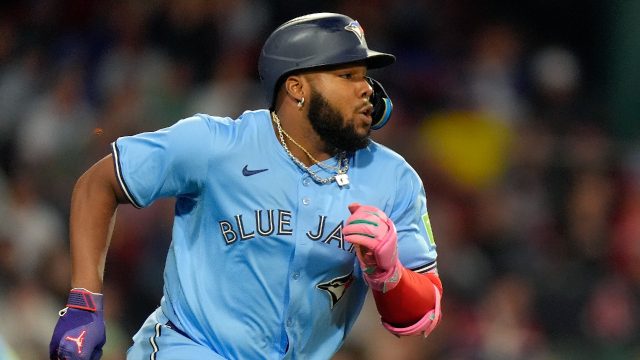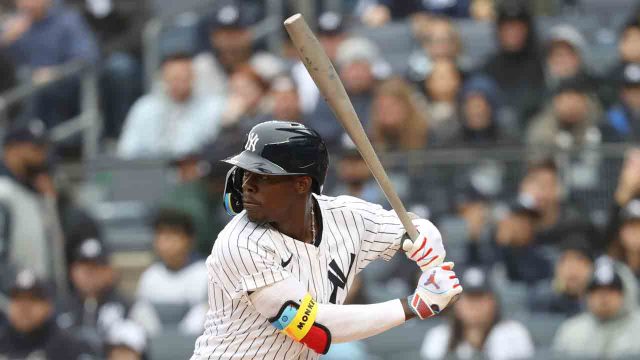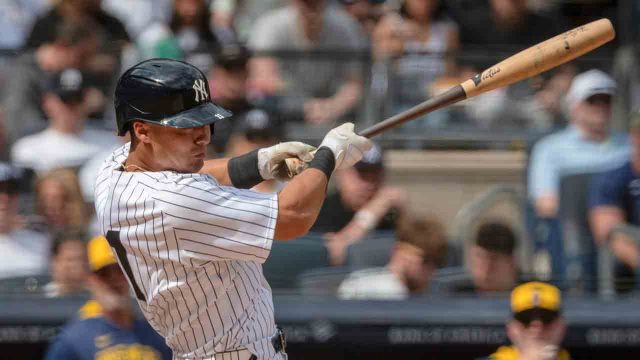
TORONTO — The Yankees hit nine home runs with help from some oddly shaped bats Saturday afternoon, and the baseball world took notice.
By Monday, some hitters were placing orders for the so-called torpedo bats while others were already a little exasperated by the topic and their coaches were reaching for the rulebook. But it’s all legal, so these new bats with the bigger-than-usual barrels and the tapered ends aren’t going anywhere. If anything, we can expect to see more of them once bat makers catch up with this sudden demand.
“Everybody’s trying to find a leg up and an advantage,” said Blue Jays third baseman Ernie Clement. “The game’s hard enough, so it makes sense that guys are trying different things. But it’s still hard as hell to hit a baseball.”
Or, as 66-year-old Brewers manager Pat Murphy put it after the Yankees’ 20-run outburst: “My old ass will tell you this, for sure. It ain’t the wand, it’s the magician.”
Even so, players like Davis Schneider are ordering their own torpedo bats and others, like Clement, are curious enough to try them out for a few swings. So, what’s happening here? Is it merely a fad that happens to be great for the bat-making business? A potential hack with the potential to give hitters a real advantage? Or simply something for the media to talk about in late March?
“All of the above,” said Blue Jays manager John Schneider. “It’s so new, you don’t really know. I think if the Yankees didn’t hit 15 homers, we wouldn’t be talking about it.”
Even before the Yankees went off for nine homers and 20 runs, Davis Schneider had a couple torpedo bats of his own. A self-described tinkerer, Schneider had noticed the Yankees using them in spring training and heard that they could generate better contact because the weight had been redistributed away from the end of the bat, where no hitter wants to connect, and towards the sweet spot on the barrel.
The innovation is attributed to Aaron Leanhardt, a former Yankees employee and MIT physics graduate who now coaches for the Marlins (“He’s got like four PhDs,” John Schneider joked). But Davis Schneider wasn’t thinking about the science behind the bat or where it came from, he just liked using it.
“It really depends on what works for you, too,” Schneider said. “It’s going to work different for each individual person, so you’ve just got to test it out.
“I kind of like the way it feels.”
Intrigued, Clement tried one of Schneider’s bats for himself (he has two now with 12 more on the way). Unlike his teammate, though, Clement wasn’t especially tempted to make a change.
“I don’t see a huge difference,” he said. “It just looks kind of funny.”
To this point in the season, Schneider has only used the bat once, during a sixth inning strikeout against Keegan Akin of the Orioles Saturday. An at-bat like that reinforces an important point in all of this: it doesn’t matter what you’re swinging if you can’t make contact in the first place, and that’s no easy feat against MLB pitching.
But, of course, the high quality of pitching in baseball is why hitters are interested in experimenting in the first place. In recent years, much of the sport’s innovation has helped pitchers, with high-speed cameras, force plates and radar-triggered pitch-tracking tools all improving pitch design – the process by which pitchers refine their pitches. Maybe it’s time the hitters got an edge back.
“It’s a pretty cool idea, just in terms of the theoretical part of ‘how can we optimize the bat,’” said Alan Roden, who majored in physics before beginning his pro baseball career. “But I think there’s a lot to explore with the give and take. What you’re getting and what you’re giving away. It’s interesting.”
It’s also possible that players could eventually use different bats in different situations, just as golfers use different clubs depending on the shot they’re trying to make. It’s an analogy John Schneider has made a few times this season, and now that metaphor may be coming to life.
“Everyone wants a new toy,” the manager said.
Still, this isn’t the first time a bat company has created buzz. A few years ago, the likes of George Springer, Mookie Betts and Dansby Swanson started using the Axe Bat, a bat with a modified knob that helped some players swing more comfortably. Longtime baseball people can recall many other such innovations.
-

-
MLB on Sportsnet
Watch the Toronto Blue Jays, Blue Jays Central pre-game, marquee MLB matchups, Jays in 30, original documentaries, the wild card, divisional series, championship series and entire World Series on Sportsnet and Sportsnet+.
“There’s always bat companies popping up,” said Nationals manager Dave Martinez. “When I played (from 1986-2001), the Hoosier Bats became available. We tried those, they were really good. They were hard, but you’ve still got to hit the ball. That’s the key. But there’s gotta be something to it, there really does.”
Some believe this development caught people’s attention because it put the Yankees in the spotlight as opposed to, say, the White Sox. But the way Martinez sees it, the fascination with the torpedo bats hasn’t been aided by the Yankees’ prominence.
“I think it was aided because of all the home runs that were hit,” he said.
Even so, there are those who believe the story’s overblown. Clement says “a lot of the media are the ones who drive the conversation,” while others note that the story might get extra attention simply because of how unusual the bats look.
“It’s interesting for sure,” said John Schneider. “It looks weird. And I think anything that is new and looks weird is story-worthy. So whether or not it’s a competitive advantage, I don’t really know. I guess we’ll see. But it looks weird for sure.”
The manager expects to see more torpedo bats as the season progresses, and he has no problem with his players making the switch if it feels right for them. Evolving with technology is essential to succeeding at the highest level of professional baseball, after all.
“It’s like a glove,” he said. “It’s just what you’re comfortable with. If you’re comfortable with it, then torpedo away.”
Of course, for the trend to catch on with a broader cross-section of players, there will have to be measurable results over a sustained period. If that happens, even the doubters might have to place some new orders.
“I’m gonna stick with what I’ve got,” Clement said. “If Davis uses it and hits, like, 50 homers, then maybe.”






